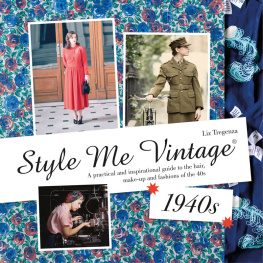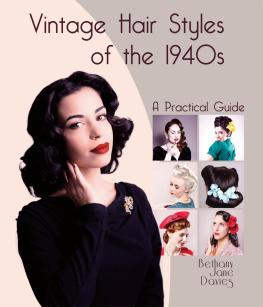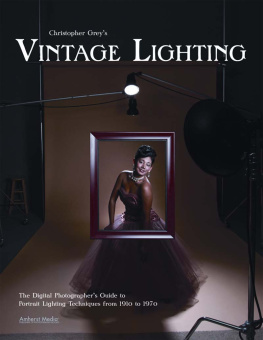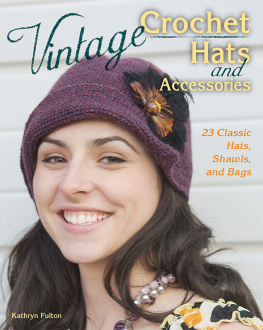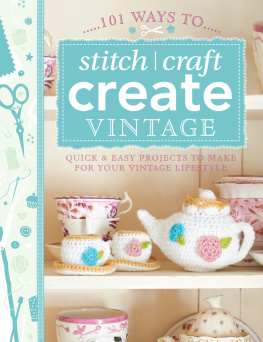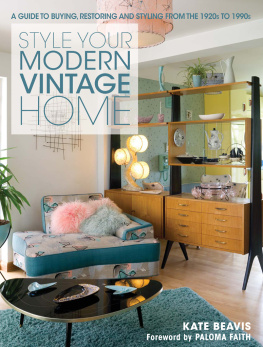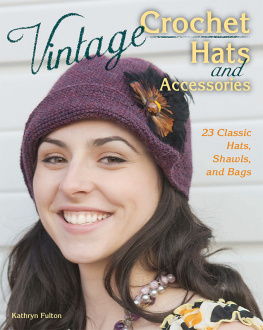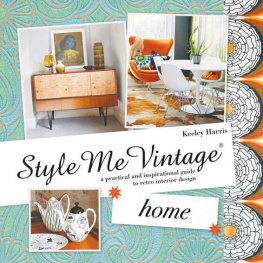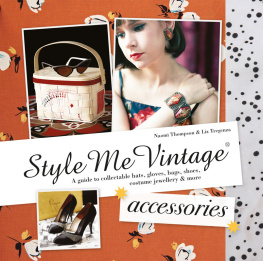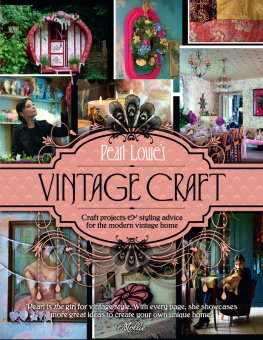

Contents
INTRODUCTION
Have you ever wanted to dress like a 40s Hollywood starlet? Or wondered how to execute the perfect Victory roll? Have you ever marvelled at how women kept themselves looking beautiful during wartime?
Whether you want to dress for a 40s evening soire, the beach, or even for your wedding, from underwear to outerwear, from cosmetics to accessories, the tips are all here.
This book is a useful guide for vintage wearers and collectors alike. It doesnt matter if you are a vintage novice or a seasoned aficionado, theres something here for you. Interesting historical snippets are mixed in with useful and easy-to-master styling tips. Ill show you how to dress in original 40s garments, try out the style with later reproductions or just add a touch of authentic 40s to your outfit. I strongly believe that vintage looks should be simple to recreate all the hair and make-up tips shown here are tried-and-tested favourites of mine.
At the back of the book Ive also included a handy list of stockists of the best vintage and repro brands to help you source your own gems.
Why a whole book about recreating the styles of the 1940s?
I have a personal fascination with the 1940s. My Nanna looked after me throughout my childhood and I was always riveted by her tales of yesteryear whether it was stories of working during the Blitz in central London aged just fourteen, or her wonderful memories of beachtime frolics with her friends. Many of the original photographs you will see here are courtesy of my Nanna and give a real impression of the life of a young Londoner during the 40s.

One of my favourite family photos, my Nanna (right) stands with her friends Joyce and Tiny on the roof of the GEC building, May 1946.
In my opinion the 1940s form an extraordinary decade in the history of womens clothing and style. This was a period of huge social and cultural change that affected every aspect of peoples lives. The perceived role of women changed drastically during the decade and it was realised that they could perform jobs just as well as men could.
The way women dressed, styled their hair and wore their make-up altered because of the war. Female appearance was no longer simply about looking beautiful, it was also a matter of practicality and versatility. Clothes were made to last and hairstyles had to enable war work. Fashion and cosmetics did their bit for the war effort they acted as a morale booster.
Sometimes the myth is propagated that fashion stopped during World War II. In Britain and the United States shortages, government regulations and wartime priorities brought slower changes in fashionable styles, yet fashion did not stop. Fashion changes between 1942 and 1946 occurred far more slowly than they had before the war, but decorative qualities still existed and women continued to update their wardrobes when coupons and funds allowed.

Youll have fewer clothes because you have not the time, money or coupons to clutter your life with non-essentials [...] youll have simpler clothes because in these days anything elaborate looks silly [...] youll have better clothes because anything you buy will be chosen after long thought to last the duration and beyond.
Vogue, November 1939

I love a good novelty print. This rayon crpe mid-1940s dress by Gracette is covered in a print of Parisian landmarks.
I wanted to dispel some misconceptions with this book. 1940s style isnt all victory rolls and drab, masculine suits brightened up with flashes of red lipstick. The 1940s was a hugely diverse decade in terms of style and, whatever your personal predilection whether you like to dress in a feminine or masculine manner, wear your hair up or down, there is a facet of 1940s style to suit you.
The most important thing to remember though is to have fun dressing in vintage should never be a chore, it should always be a pleasure. Use this book as a guide to help you hunt out those forgotten 40s treasures, make yourself feel like a 40s film star, or accurately recreate the swish of Diors New Look.


Make-up

Cosmetics are as essential to a woman as a reasonable supply of tobacco is to a man.
Mr. Henderson, Ministry of Supply, Vogue, August 1942
When most people think of 1940s make-up, it is the bold red lips of the decade that spring to mind. This, more than any other aspect of 1940s make-up, defines the era and was worn by women of all classes around the world. But theres more to 1940s make-up than just red lipstick.
The predominant make-up look of the 1940s was a natural, healthy one pale to slightly tanned skin tones, gently pencilled brows, a thin coating of mascara, a dusting of pink to the cheeks, and all of this was topped off with a splash of that red lipstick.
HISTORY
During the 1940s, as numerous cosmetics advertisements suggested, beauty was a womans duty. Make-up had a powerful effect on women and men alike during the war and women were actively encouraged to wear it. Wartime cosmetics advertisements presented powerful, strong women doing their bit for the war effort. A series of Yardley advertisements advocated that women should put your best face forward. Make-up was seen as a morale booster, not only for the women who wore it, but also for the men who saw these glamorous women. Good looks and good morale were considered allies.
Wartime austerity however, particularly in Britain, limited womens cosmetics choices. In 1940 cosmetic production was cut to just 25% of pre-war levels. The metal used for casing cosmetics was needed for armaments. Petroleum and alcohol essential ingredients for beauty products were needed for the war effort too. Even soap was rationed, as glycerine was required for making munitions. It was far easier to purchase cosmetics in the United States than it was in Europe because the chemicals needed to produce them were not in such short supply.


